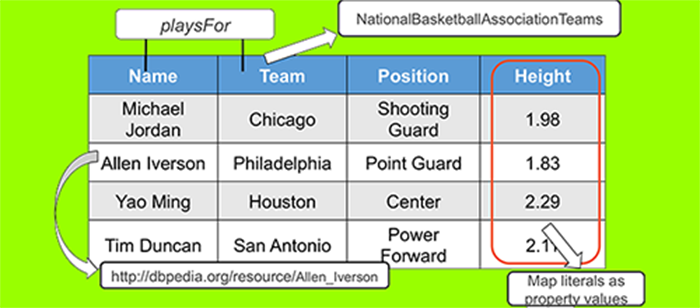
Dissertation Defense
TABEL — A Domain Independent and Extensible
Framework for Inferring the Semantics of Tables
Varish Vyankatesh Mulwad
8:00am Thursday, 8 January 2015, ITE325b
Tables are an integral part of documents, reports and Web pages in many scientific and technical domains, compactly encoding important information that can be difficult to express in text. Table-like structures outside documents, such as spreadsheets, CSV files, log files and databases, are widely used to represent and share information. However, tables remain beyond the scope of regular text processing systems which often treat them like free text.
This dissertation presents TABEL — a domain independent and extensible framework to infer the semantics of tables and represent them as RDF Linked Data. TABEL captures the intended meaning of a table by mapping header cells to classes, data cell values to existing entities and pair of columns to relations from an given ontology and knowledge base. The core of the framework consists of a module that represents a table as a graphical model to jointly infer the semantics of headers, data cells and relation between headers. We also introduce a novel Semantic Message Passing scheme, which incorporates semantics into message passing, to perform joint inference over the probabilistic graphical model. We also develop and explore a “human-in-the-loop” paradigm, presenting plausible models of user interaction with our framework and its impact on the quality of inferred semantics.
We present techniques that are both extensible and domain agnostic. Our framework supports the addition of preprocessing modules without affecting existing ones, making TABEL extensible. It also allows background knowledge bases to be adapted and changed based on the domains of the tables, thus making it domain independent. We demonstrate the extensibility and domain independence of our techniques by developing an application of TABEL in the healthcare domain. We develop a proof of concept for an application to generate meta-analysis reports automatically, which is built on top of the semantics inferred from tables found in medical literature.
A thorough evaluation with experiments over dataset of tables from the Web and medical research reports presents promising results.
Committee: Drs. Tim Finin (chair), Tim Oates, Anupam Joshi, Yun Peng, Indrajit Bhattacharya (IBM Research) and L. V. Subramaniam (IBM Research)